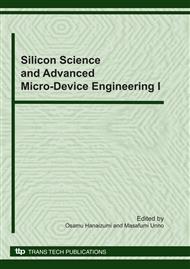p.67
p.71
p.78
p.84
p.92
p.100
p.111
p.116
p.120
Application of Micro-Metal Textile for Flexible Dye-Sensitized Solar Cell
Abstract:
As a means to make a flexible dye-sensitized solar cell (DSSC), we prepared a TiO2 electrode by using a micro-metal textile made from Sn-plated Cu wires, and examined applicability of the micro-metal textile as a substrate for the electrode. The TiO2 electrodes were prepared successfully by painting a TiO2 paste to the textile using a squeegee method followed by sintering at 500 °C, and the electrodes showed no exfoliation of the TiO2 layer from the textile even when the electrode was bent to a cylindrical shape with 10-mm diameter. The solar cells constructed with these electrodes, on which N3 dye was adsorbed as a sensitizer, exhibited actually a photovoltaic performance. The results indicated the applicability of the micro-metal textile as the flexible substrate for the TiO2 electrode producing an efficient flexible DSSC.
Info:
Periodical:
Pages:
92-99
Citation:
Online since:
December 2010
Authors:
Price:
Сopyright:
© 2011 Trans Tech Publications Ltd. All Rights Reserved
Share:
Citation:



